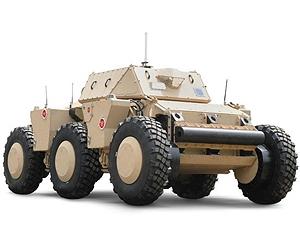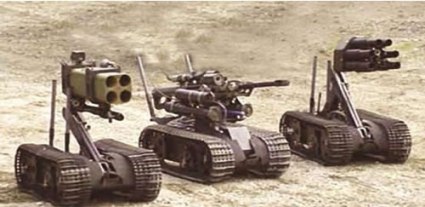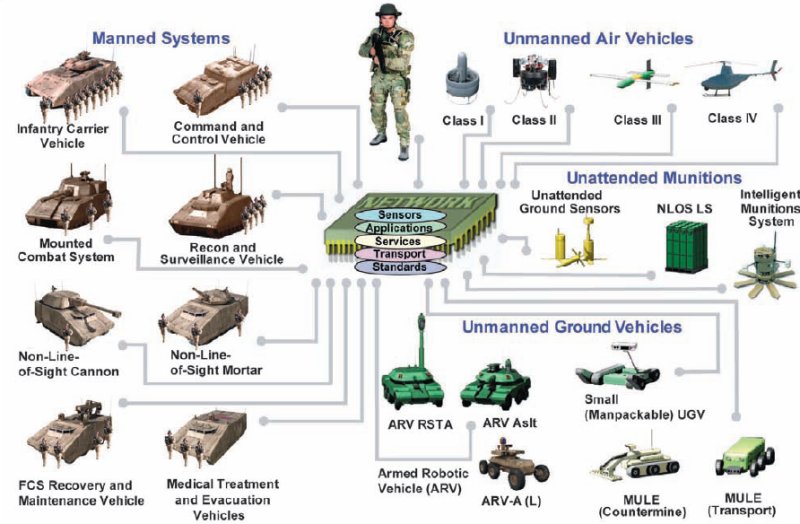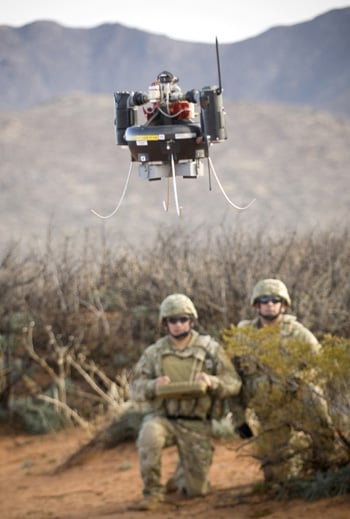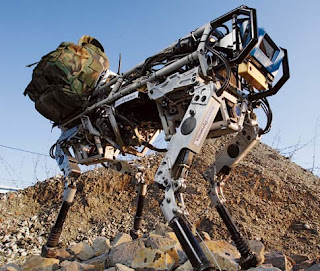How the U.S. Military Can Win the Robotic Revolution
One of the great conundrums of war and technology is the odd fact that there is no such thing as a permanent first-mover advantage. Commodore was an early leader in personal computers, developing and marketing the world's best-selling desktop computer, the Commodore 64; it went bankrupt in 1994.
The Ottoman Turks were the first to successfully master the use of gunpowder in fluid battle plans, becoming a powerful empire that spanned three continents; soon after, their armies were routed and they were pitied as "the sick man of Europe." Time and again, whenever a remarkable new technology came along, the early leaders soon fell far behind.
Today, the U.S. military may be wrestling with a similar challenge. In the bureaucratic blink of an eye, it's become a dominant power in the potentially game-changing field of military robotics. When the U.S. military went into Iraq in 2003, it used only a handful of unmanned systems in the air, none of them armed. On the ground, the invasion force used zero unmanned ground vehicles. Today, we have over 7000 unmanned aerial systems in our inventory—48-foot-long Predators, micro-aerial vehicles that a single soldier can carry in his rucksack, as well as lawnmower-size PackBots on the ground and Talons that help find and defuse deadly roadside bombs.
Such war bots may be part of an important turning point in history.
Scientists describe unmanned systems today as being where the horseless carriage was back at the turn of the last century. Chief James A. Roy, the head of the Air Force, says they are the equivalent to the advent of the airplane, while Bill Gates has compared robotics today to where computers were back in 1980.
Indeed, as much as they seem like science fiction, such PackBots and Predators are merely the first generation—the equivalent of the Model T Ford or the Wright Brothers' flyer. Even so,
they are having a huge impact already on everything from when and where we go to war ( the U.S. has carried out over 120 air strikes into Pakistan, using unmanned systems, without any congressional debate) to the warrior's very experiences (a young pilot can now "go to war" without ever leaving Nevada). Even more, the next generations of this technology are becoming ever more intelligent and autonomous, which bodes even greater change.
The Military's Slow March to Embracing Technology
Often, militaries are slow to adapt to such revolutionary technologies, including even the sometimes technology-obsessed U.S. military. The machine gun, for example, was invented in 1861, but even with the Civil War raging at the time, it was eschewed by military leaders and wouldn't be used, in fact, for decades.
Even when the machine gun began to be used widely during World War I, over a half-century later, it still took several bloody years before the generals acknowledged that they had to change the way they planned battles.
The devastating firepower of the machine gun meant that charges across no man's land weren't just ineffective, but suicidal. As one French officer said in 1916, after the battle of Verdun left 700,000 killed or maimed, "Three men and a machine gun can stop a battalion of heroes."
Working in a realm where reliability can mean life or death, it is not surprising that militaries are often slow to adapt to emerging technologies. Indeed, in 1938, when U.S. Army Gen. Hamilton Hawkins lamented the "foolish and unjustified discarding of horses" in favor of the tank, he actually was making what seemed like a pretty good point at the time. Horses had over 4000 successful years of war behind them, while tanks barely had two years of not all-that-remarkable experience toward the end of World War I.
Change is also slow because of turf battles and bureaucratic wars. Those whose talents or training could become outdated by new technologies will often fight anything that threatens their prestige. The engineers on the early Navy steamships, for instance, weren't even allowed to eat at the same table with the other officers, because to work with such a messy technology as a steam engine wasn't considered worthy of gentlemen who had grown up in the age of sail.
All these barriers have been in play with military robotics. The Predator may seem like a new technology, but it dates to the early 1980s. It wasn't until after the 9/11 attacks, as the Predators began to prove their worth in Afghanistan, that the Air Force started buying the system in appreciable numbers. Senior leadership was viewed as somewhat resistant to unmanned systems, while the internal culture was less than hospitable. Early pilots assigned to operate the unmanned planes flying out of Nellis and then Creech AFB describe "going kicking and screaming" because of the harm they feared assignment to flying robotics planes would do to their long-term careers.
Yet, now, this corner seems to have been turned. The current Air Force leadership has gone out of its way to describe unmanned systems as the future of the force. This year, the
Air Force will train more unmanned systems operators than it will manned fighter plane or bomber plane pilots combined. And the service has adopted a road map that plans out an ever-growing use of robotic aircraft to the year 2047 (the service's 100th anniversary). The same change is also playing out in the Army, which actually flies just as many unmanned systems as the Air Force, and has its own robotic roadmap out to 2035 which plans for everything from tiny micro-drones to unmanned versions of the Apache helicopter.
The Perils of Success
Given that fact that a key mistake in history is the failure of leaders to adapt, the military should be extolled for its embrace of robotics. But, before we honor our (metallic) hands too loudly, we're not yet through the storm. There is a second peril we still have to weather. Often,
shortly after overcoming their initial resistance, there is a tendency for leaders to latch onto the next big thing before the exact nature of that thing is actually determined. They choose to change before they know the best choice. That is, adapting to the game-changing nature of a technologic revolution is a lot like falling in love.
One danger is to not commit. The other is to commit too early.
Not only do first movers pay for the original investment in a technology (which their competitors can then free-ride off of), but many make a crucial mistake. They lock into the early design and usage models that worked in the first wave of the new technology, but often turn out to be not the best as the technology progresses. Having met with early success, they forget the standard warning given to mutual fund investors: "Past performance is not necessarily indicative of future performance."
A good example of this is the British experience with aircraft carriers. Despite being the leading sea power of the day and hugely invested in battleships, the Royal Navy was also the first to develop and use the new type of ship that took the incredible new technology of airplanes out to sea: the aircraft carrier. But during the interwar years, it committed to a single type of carrier. By contrast, the United States Navy experimented greatly, building three vastly different types. Fortunately for America in World War II, one of those types, a large and flexible ship that carried enough planes both to defend itself and pack a substantial punch, turned out to be the best for the new ways of war at sea. Unfortunately, for the British, this was not the type they had committed their military and industrial shipyards to—and they never caught up.
The same early commitment and failure to diversify similarly characterized the British history with the tank. This was another science-fiction-like technology (first coined the "land ironclad" By H.G. Wells) that the British invented and were the first to use in World War I. But the Germans figured out how to use it better by World War II. The number of tanks the British had at the end of World War I was 12,000, almost the same number of ground robotics the U.S. has today.
A worry is that the same historic trend may well be repeating itself today at the Pentagon. At the center of our road maps for a military robotics future is a plan for a remarkable next-generation plane called the MQ-X (the original Predator is the MQ-1, its current replacement is the MQ-9 Reaper, so the X stands for the future, yet-to-be-decided number). As currently conceived, the
MQ-X will be a stealthy, faster fighter-plane size version of the current unmanned systems. Even more, it will be a jack-of-all-trades, able to take over the old jobs of not only the first generation of Predators and Reapers, but also of manned planes that range from the U-2 spyplane to the F-16 fighter jet and even to cargo and tanker aircraft. It might carry high-performance surveillance sensors like the next-generation version of Gorgon Stare or Argus (Autonomous Real-time Ground Ubiquitous Surveillance), wide-area cameras able to track 92 different targets on the ground at once. Or it might be equipped in a fighter-attack mode, carrying a retractable cannon, missiles and bombs inside the payload bay. Or the very same plane might be reconfigured to carry a cargo load. As the head of the acquisitions process described, the MQ-X will have the speed and characteristics of a fighter plane, but act like a truck.
In covering such a range of potential roles, many see the
MQ-X as the future of American airpower, and perhaps one of the biggest contracts in the coming decade, not just for unmanned planes, but for the overall aerospace industry. Indeed, each of the major defense contractors that eschewed robotics just a few years ago is gearing up to bid on the MQ-X's development contract, which is rumored to be given in 2010.
As powerful and persuasive as the MQ-X concept sounds, its centrality is also ringing many of the same warning alarms of past revolutions, worries perhaps made even worse by the problems in the current Pentagon acquisitions system.
From the Army's Future Combat Systems, the Navy's Littoral Combat Ship, the Air Force's F-22, and the Marines' Expeditionary Vehicle, to their collective F-35 Joint Strike Fighter, the current weapons development process has consistently steered toward massive programs, usually described as "too big to fail," that try to meet all needs and are run by a few major contractors, with the Pentagon making a commitment to buy before even the prototypes are fully tested out. In so doing, the process takes so long that by the time the actual weapons are ready to be used in the field, the original need and design parameters have long passed (indeed, if the contract is signed in 2010, even the most optimistic Pentagon schedule doesn't have the MQ-X ready until 2020).
So, what starts out as a great idea that is supposed to appeal to all ultimately becomes so over-engineered, over-priced and out-of-date that it ends up not being a good option to anyone. You may start out wanting a stealthy robotic fighter jet, crossed with a truck; instead you may end up getting the military equivalent of the Pontiac Aztek.
Now Is the Time to Experiment
At the start of this revolution in robotics, it is folly for us to think we have all the answers yet. Back in World War I, the early tanks were visualized as mobile pillboxes, supporting infantry as they marched on trench lines. It later turned out, though, that the technology could be far more effective when gathered together into a single armored punch, a
blitzkrieg that moved at a speed well beyond that of a soldier's legs. Similarly, the future of unmanned weaponry may well be jacks-of-all-trades like the MQ-X or robotic Apache helicopters that look and operate very much like the manned and early unmanned versions they are replacing. Or, it might be something as vastly different as the Rand Corporation's concept of PRAWNS (PRoliferated Autonomous WeapoNS). In this, rather than a single large (and likely expensive) plane trying to do it all, the task is divided among a variety of smaller, cheaper specialized robots, much like a swarm of ants at work. Much as no one knew the full potential of tanks back in 1918, we similarly don't know which model of war robots will ultimately win out.
The answer then is not to turn back the clock on technologic change and cling to old systems or doctrines. Nor is it to leap before looking. Rather, now is the time to experiment, to play the field and be promiscuous with our technologic futures. Whether it's Apple and its i-Initiative or the interwar German Wehrmacht and the over 30 committees and wargames it set up after World War I to learn the lessons of how to best use the new technologies of tanks and airplanes, the winners in these technologic revolutions are consistently those who are studious, but flexible. They are willing to explore and embrace the new, but not commit themselves until they truly have a sense of the technology and the changes it represents.
For the U.S. military, it means we should focus less now on what the perfect robotic system will look like 20 or 30 years out, fighting for kids not born yet in battles we know not where. Instead, we should return to our own tradition of experimenting, pushing multiple design contests and encouraging vast testing of prototypes, so as to ensure that our current defense purchasing isn't pre-emptively deciding how we will fight in the future, but rather allows us to choose what will be best in that future. And if these winning designs don't come from the current leaders on the manufacturing side, so be it. Much as in the history of automobiles or computers the most innovative and perhaps ultimately effective ideas are just as likely to come from the risk-taking small companies as they are from the market behemoths.
In sum, the key to successfully weathering a revolution isn't merely being willing to risk change; it's also being able to spread out that risk, so that you end up making the right choice.
Source




